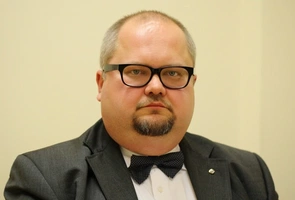In hope we are saved: Man's Hope for Eternal Life
Komentarz do encykliki Benedykta XVI "Spe salvi" / A commentary to the "Spe salvi" encyclical, English translation (Chapter VI)
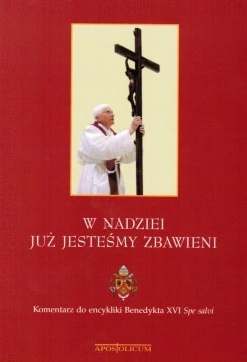
Rev. Jerzy Lewandowski
HOPE IN SALVATION AND SALVATION IN HOPE
In hope we are saved
A Commentary on Benedict XVI's encyclical letter Spe salvi
A Collective translation reviewed and corrected by Filip Maj
Warszawa 2010
VI. Man's Hope for Eternal Life
All cultures and religions, theologies around the world attempt to present the relation of man and God not only throughout the life of man, but also after the death. In ancient Europe the Greeks knew Hades, the Hebrews had Sheol and Paradise, the Christians - Hell, Purgatory and Heaven as well as many transitional places that a dead person's soul had to go through to clean itself after the earthly life. Man can be reborn in another body or be released from the bodily life and go on to enjoy the immediate closeness of God as His essence. The encyclical letter of Benedict XVI Spe salvi is devoted to a theological analysis of the saving function of hope and is a reflection on the Christian vision of salvation. It takes up this issue in relation to the mystery of Jesus Christ's birth and death.
Jesus Christ is the God-man, born „in eternity” from "the Father" and "in time" from the "Virgin Mary". He is the Messiah expected by the Eastern World to save the whole world. He has had his archetypical predecessors. In the ancient eastern cultures, the Messiah was expected for many thousand years before Christ, e.g. Horus in Egypt for 3 000 years, Attis in Phrygia for 1200 years, Mithra in Persia for 1200 years, Krishna in India for 900 years, Dionysos in Greece for 500 years before Christ etc. In the times of Jesus and before him there were many candidates for the role of the "Messiah". At first they were admired, then unmasked and killed. Jesus, who was not "recognized by his own people", suffered the same fate. The Jews are still expecting the Messiah to come. They believe that he has not been born yet.
The Christians, who merge the eschatological knowledge of philosophers and the knowledge and wisdom of the prophets of Israel, consider Jesus the one who 1) was "begotten of his Father before all worlds" 2) and born "in time" of Virgin Mary in ancient Palestine, 3) was a teacher, had twelve disciples, 4) was betrayed and killed, 5) died for the salvation of the world, and 6) on the third day rose again, 7) "shall come again with glory to judge both the quick and the dead: whose kingdom shall have no end" (Creed). From the earliest times, the prospect of the Judgement has influenced Christians in their daily living as a criterion by which to order their present life, as a summons to their conscience, and at the same time as hope in God's justice (Encyclical, n° 41). Today, the situation is different —
many people in Europe have doubts about the faith in the resurrection of the body. Faith is stronger concerning the healing of souls and their incarnation in new forms of life, as well as the acceptance of their immortality.
Benedict XVI portrays two visions of justice: Greek and Judaic. They are worth elaborating, since the believers themselves lack knowledge about it and know little of the Holy Scripture or limit themselves to the catechismal presentation. The "holy scriptures" of Greece - Homer's Iliad and Odyssey, as well as Hesiod's Theogony depict images of the afterlife world (cf. Zieliński 1921). Its main problem is the souls' stay in Hades after the death of the body. It is a place of oblivion and recollection, purgation and recovery, fair suffering and expectation that is full of hope for new incarnations and a return to the "divine procession". God, gods, the moirai and daimons, as well as one's own deeds had an influence on man's fate in life and after death.
The idea of "God's Providence" was expressed more clearly by Epicurus, who pondered on the "prosperity of the bad and misery of the good". It also finds its expression in the idea of "God's grace" in Judaism (the dilemma of Job) and in Christianity (the dilemma of Jesus). Stoicism takes up this issue as well, referring in its knowledge of the afterlife to the Orphic mystery cults. The soul is immortal individually; after its terrestrial life it will be judged and then both rewarded and punished. The famous "Il sogno di Scipione", which Cicero's "De re publica" ends with, provides quite a majestic description of a stoic paradise, which delighted many even in the Christian times. In any case, if you want to, you may believe it or not. Stoicism, being akin to the religion of Apollo in this respect, recognizes the afterlife world, but is not occupied with the details. (...) Stoicism and Epicureanism ruled the minds for four centuries both before and after Christ, and in this era it was Rome, not Greece, that was the arena of human culture (Zieliński 1921: 112).
Descriptions of life in death and after it were interpreted not only in myths, poems or dramas, but also in philosophical analyses. Plato gives the following description in the dialogue Gorgias that Benedict XVI quotes: Often, when it is the king or some other monarch or potentate that he (the judge) has to deal with, he finds that there is no soundness in the soul whatever; he finds it scourged and scarred by the various acts of perjury and wrong-doing ...; it is twisted and warped by lies and vanity, and nothing is straight because truth has had no part in its development. Power, luxury, pride, and debauchery have left it so full of disproportion and ugliness that when he has inspected it (he) sends it straight to prison, where on its arrival it will undergo the appropriate punishment ... Sometimes, though, the eye of the judge lights on a different soul which has lived in purity and truth ... then he is struck with admiration and sends him to the isles of the blessed (Gorgias 525a-526, qtd. in Encyclical, n° 44). The two main metaphors of judgement: 1) prison and 2) release, determine the image of the afterlife in ancient Greece. Similar metaphors of judgement can be found in Jewish and Christian theologies.
In his description, Plato expresses a premonition of just judgement that in many respects remains true and salutary for Christians too. Albeit using mythological images, he expresses the truth with an unambiguous clarity, saying that in the end souls will stand naked before the judge. It no longer matters what they once were in history, but only what they are in truth (Encyclical, n° 44). The notion of truth can be linked to the notion of Logos, whose first theoretician in Greece was Heraclitus of Ephesus (+480 BCE), and then Philo of Alexandria (+50 CE). In Greece, Logos was already identified with God, being the godly son of Hermes, the patron of shepherds; next we find the identification of Logos-Truth with God in the Gospel of John. Man cannot be judged for his own life's history, but for his relation to the Truth-Logos-God. Man's life history is an outcome of this relation and one's actions, as well as the life situation that he carries out in the individual and collective life plan on earth.
In its theology, Judaism describes Judgement Day (Hebr. Jom ha-Din) - the End of All Days - as an event to take place after the coming of the Messiah. It is then that the Resurrection will take place, when the people of Israel, as well as non-Jewish peoples, will be summoned by the sound of trumpets to the Lord's Judgement. Elijah the prophet will perform the procedure of the Judgement; he will be sent back on earth to reconcile families before the coming of the great and dreadful day of the Lord, he shall turn the heart of the fathers to the children, and the heart of the children to their fathers, (Mal 3:24); the day of the Lord is darkness, and not light (Am 5:18), with storm and tempest, and the flame of devouring fire (Is 29:6). In Jewish liturgy the New Year's celebration (Rosh Hashanah) is also referred to as "the Day of Judgement". Ram's horn (shofar) is blown at that day, and God judges the world, deciding on the fate of each person in the year to follow (cf. Unterman 2003: 79).
In the Five Books of Moses, that is the Jewish Bible, little is said about the immortality of the soul and the afterlife. This theme is elaborated on in rabbinic and kabbalistic literature, as well as in Jewish folklore. According to these traditions, a dead person's soul maintains communion with the material body for 7 days after death. It wanders secretly to and fro between the cemetery and the house. For the next 12 months the soul descends from Heaven to earth until the body is finally putrefied. The deceased's son recites the kaddish for 11 months to help the soul free from these ties, as well as of the purgatorial stage - Gehinom, before the soul ascends into its place in Heaven, where purified, it can "enjoy the light of Divine Presence (Shekhinah)". After death, the soul returns to its spiritual dwelling, in comparison with which, life on earth was just a form of refuge.
A pious Jew can recognize what awaits him after death while still living here on earth (illumination). Moses reached the highest form of communion with God in this world, and once he died, he was at once in the highest mystery of God's Being, without the regular procedure of judgement over human soul. The soul returns to a new body after death until it fulfils its destiny (Unterman 2003: 305). One is prepared for it from the early days, e.g. through circumcision (Hebr. "brit milah" - "covenant of circumcision"). Thanks to it, the circumcised may reckon that Abraham will protect them from posthumous punishment.
The world at the end of the days (Hebr. Olam Haba - "the world to come"), after the coming of Messiah, will be totally different - unseen, unheard of, one that the soul cannot imagine now. The earthly world is a "corridor" to the "main Chamber", where all Israelites who deserve it will be let in, including the representatives of other cultures as the "Righteous among the Nations". In every generation there are thirty righteous "goys", whose merits keep all non-Jews alive. Their righteousness allows them to unite with God and to receive a special honour after their death.
The teachers of the Law enumerate categories of people that can hope to be honoured in this way - from the humble to those who managed to "walk the four cubits in the Land of Israel". Those who humiliated others in public, pronounced the Tetragrammaton, read apocrypha instead of the Scripture, courted women, were doctors or heretics (Hebr. Aprikoros) will not be accepted . There will be no procreation, eating and drinking, trading, envy, hatred and rivalry in the new world, and the righteous will be seated and crowned in the light of Shekhinah (cf. Unterman 2003: 205-206).
Jews believe that there is a special kind of vocation and death of sages. This is because there is an Academy on High —the heavenly yeshivah, where God and the unborn Messiah, together with the souls of the dead fathom the Torah. They study the same subjects that are studied on earth, and in matters of Halakha, various views of scholars are recalled and belabored. In case of a disagreement between God and the rest of the Academy, advise may be sought from one of the living sages. Summoned to the Heavenly Academy, he dies to give his statement that may not necessarily be in agreement with the God's view. This idea initiated the use of the expression "summoned to the Academy on High" as a euphemism for a scholar's death (Unterman 2003: 16).
Describing the Last Judgement in Christianity, Benedict XVI points to its axiological, anthropological and kairological (special time dimension) aspects. Faith in Christ has never looked merely backwards or merely upwards, but always also forwards to the hour of justice that the Lord repeatedly proclaimed. This looking ahead has given Christianity its importance for the present moment. (Encyclical, n° 41). The Last Judgement is an idea of the moral assessment of man and the deeds he performed during his earthly life. It can lead to favorable decisions made by God or eschatological decisions of punishment that are meant to repair the subject being punished.
The record of the "Last Judgement" is based on the Bible, gospels and the history of faith coming from the culture of the Middle East. At first, God did not have the intention to establish the judgement, for He created man in His own image. It was not about iconic similarity between man and God though, but the relation between them. Adam and Eve broke this primary relation and provoked God's angry reaction to complement His love with justice that people were to be subjected to. As the records of the Mediterranean tradition show, God made new covenants with people every now and then (e.g. Noe, Abraham, Moses) that were always violated with sin. This is why he sent his Son to earth to re-establish His relation with man. People's reactions to this decision were ambivalent - some admired Him, others hated Him. Killing the Son of God by the decision of the court influenced the understanding of the Christian revelation.
Benedict XVI reminds us how the Church tried to show the duality of man's position in relation to God. He is subject to both the right of justice (judgement) and love (hope). The Church as an institution of spiritual education has kept to this truth for two thousand years, not only in verbal, biblical and gospel records, but also in liturgy and iconography (in music, paintings, sculptures and architecture - cf. Ratzinger 2005). In the encyclical letter Spe salvi, the following remark complements this statement: In the arrangement of Christian sacred buildings, which were intended to make visible the historic and cosmic breadth of faith in Christ, it became customary to depict the Lord returning as a king—the symbol of hope—at the east end; while the west wall normally portrayed the Last Judgement as a symbol of our responsibility for our lives (Encyclical, n° 41). These two sides of human life, the two sides of our nature: the theological and anthropological, are expressed in the culture and religions of the world.
We know from Plato's conception of man that the first force controlling the discordant reactions of soul is justice, while the second, and the more powerful one is love. In eastern cultures, images of power, which retained the existing social and political order, played a more important role in their spiritual education. The religious order was consolidated by the images of theological power, such as "God the King", "God the Judge" etc. They accompanied people on their "path to daily life". As the iconography of the Last Judgement developed, however, more and more prominence was given to its ominous and frightening aspects, which obviously held more fascination for artists than the splendour of hope, often all too well concealed beneath the horrors (Encyclical, n° 31). The threat of the judgement had an effect on everyone, especially the benighted minds that needed to be frightened to act decently and within certain limits.
The problem of salvation was reduced in modern times. The theological idea of collective salvation soon changed into a political idea of social revolution. Revolutions always operate with theological symbols, but soon (after three centuries) these were excluded from it too. In the modern era, the idea of the Last Judgement has faded into the background: Christian faith has been individualized and primarily oriented towards the salvation of the believer's own soul, while reflection on world history is largely dominated by the idea of progress. while reflection on world history is largely dominated by the idea of progress. The fundamental content of awaiting a final Judgement, however, has not disappeared: it has simply taken on a totally different form (Encyclical, n° 42). The social theory of salvation was opposed to the theology of salvation, as an attempt to make use of the creative energy of man which was blocked by moral fear.
Benedict XVI thoroughly examines the exchange of the theology of salvation for the politics of salvation. He sees it not only as a movement against God, but rather against social systems which are sanctioned theologically by fear. It is a paradox that this social "movement of hope" took on the form of "atheism" which, after all, demanded the realization of theological postulates that had been known for ages. The atheism of the nineteenth and twentieth centuries is—in its origins and aims—a type of moralism: a protest against the injustices of the world and of world history. A world marked by so much injustice, innocent suffering, and cynicism of power cannot be the work of a good God (Encyclical, n° 42). The atheism in this century is not only a social morality but also a religious alternative with moral grounds. That is why it continues to play a great role in social politics.
Every system that lacks the theological dimension of hope has to come up with one or develop a substitute idea. This is what happened in the times of the rule of violence in the feudalistic or capitalist systems. Reducing justice to the needs of the elites in power, as it happens sometimes, changes the very understanding of it. If God defended the elites only, it would be necessary to question the meaning of His existence. A God with responsibility for such a world would not be a just God, much less a good God. It is for the sake of morality that this God has to be contested (Encyclical, n° 42). As hope is reduced and concentrated around the wealthy and the people in power, which was stressed, for instance, by Western Protestantism that sought to prove this was what God's blessing was about, opposition and protest must occur not only against those "materially" and "spiritually" "blessed", but also against God Himself as the idea and power that justify such injustice and limit common human hope.
What results from the elitist thinking about God is social and religious alienation, i.e. exclusion from the system of justice that the Gospel promises to all people on earth. The degradation of the moral system triggered reflexes of defence. Since there is no God to create justice, it seems man himself is now called to establish justice (Encyclical, n° 42). Bringing one's own justice is a form of psychological defence against the lack of values that sanction human life.
The need to establish "one's own justice" as an alternative to "theological justice", and later on as "the only justice" of the people themselves, changed the development of the whole European culture. The rejection of the transcendent justice to man and basing social systems on the idea of immanent justice alone ended tragically. It triggered a "fight for justice" to change the existing system, which however, perverted, reduced or annihilated the very ideas of justice.
Benedict XVI analyses the changes of justice enabled by injustice, by pointing out not only their moral, but also negative logical aspect. If in the face of this world's suffering, protest against God is understandable, the claim that humanity can and must do what no God actually does or is able to do is both presumptuous and intrinsically false. It is no accident that this idea has led to the greatest forms of cruelty and violations of justice; rather, it is grounded in the intrinsic falsity of the claim. A world which has to create its own justice is a world without hope (Encyclical, n° 42). The assumption that it is possible to create an immanent justice is erroneous, for if it existed, it would have emerged on its own. Since it does not, this assumption must be considered as false.
Alternative ideological and organizational systems have been established on the grounds of the idea of immanent justice and out of the conviction that such justice is possible. However, there is no real justice without responsibility, for it is not just immanent (inborn). It has to be assumed and designed or discovered outside of the system it organizes, regulates and steers at present. What is needed is a transcendent principle that could influence the internal order of relations between people, e.g. a principle of freedom and love. What can we do in a situation where justice is questioned for centuries, and love and freedom are constantly reduced for the sake of the system? No one and nothing can answer for centuries of suffering. No one and nothing can guarantee that the cynicism of power—whatever beguiling ideological mask it adopts—will cease to dominate the world (Encyclical, n° 42). The conclusions of this analysis are negative for both immanentism (atheism) and transcendentalism (theism).
Benedict XVI shows Catholic theologians how to analyze the contemporary studies on justice without any intellectual or religious traumas, without getting offended by their results and formulations that come from different schools of thought, including the ones of Marx and Freud, whose role in the building of European systems and world projects of social life is enormous these days. We need to accept the fact that the great thinkers of the Frankfurt School, Max Horkheimer and Theodor W. Adorno, were equally critical of atheism and theism. Horkheimer radically excluded the possibility of ever finding a this-worldly substitute for God, while at the same time he rejected the image of a good and just God (Encyclical, n° 42). Results of researches on the functioning of social justice must be given a serious thought, and we need to try to understand them in a theological dimension.
Few theologians know what the Frankfurt School was, and many know little or almost nothing. This is because they do not study all the theories of sociology or social philosophy, but are devoted to thinking through dogmatic formulas, which is certain and worked out. The idea of the Institut fur Sozialforschung in Frankfurt emerged in 1922 and was brought to life at the University of Frankfurt am Main in 1924. At first, it was a centre for documenting the labour movement, where economic studies illustrating the breakdown of capitalism were collected. In the next phases, new intellectual conceptions were worked out to support the changes in the workers' position, because they were losing their subjectivity and dignity in the new working system. The intellectuals it gathered (e.g. G. Lukacs, K. Korsch, M. Horkheimer F. Pollock, H. Marcuse, E. Fromm and others) would take up issues of the workers' religious alienation and losses they suffered as a consequence. In 1933 national socialists closed the Institute, and in 1934 it was moved to the USA to return back to Frankfurt only in 1950.
Frankfurt school thinkers tried to adopt the ideas of Hegel (dialectics and the identity of "Otherness"), Marx (alienation and freedom), Freud (suppression and projection) to their own conception of solving social crises. They also included some ideas of Judaism (the theology of "the Other"), socialism and communism. Their critical thought covered theological (religious studies), ethical and aesthetic problems. Benedict XVI points to Horkheimer and Adorn's opinions on such detailed questions as, for instance, the role of the images of God in creating the images of human justice in the religious dimension. On M. Horkheimer's view the following is said: In an extreme radicalization of the Old Testament prohibition of images, he speaks of a „longing for the totally Other” that remains inaccessible—a cry of yearning directed at world history (Encyclical, n° 42). The Judaic foundation of Marxism was and still is a driving force of contemporary social projects, which in some way refer to the Enlightenment of the XVIII century Europe, as well as to the theological discussions of ancient Israel.
The same line of thought is present in Theodor W. Adorno's witings: Adorno also firmly upheld this total rejection of images, which naturally meant the exclusion of any „image” of a loving God. On the other hand, he also constantly emphasized this „negative” dialectic and asserted that justice —true justice—would require a world „where not only present suffering would be wiped out, but also that which is irrevocably past would be undone” (Th. Dorno, Negative Dialektik (1966) vol. III, 11, in: Gesammelte Schriften Bd. VI Frankfurt/Main 1973, p. 395, qtd. in: Encyclical, n° 42). The conception of the recreation of the world turning away from evil, and thus, in fact, „converted” to the good of creation is not possible neither theologically (for it is God's domain), nor sociologically (for the actions of social systems are irreversible). It is impossible both in the future and, above all, in the past, since we cannot turn back the course of time and social structures attached to them.
Theodor W. Adorno is right in saying that such a turning-back would not be possible without the resurrection of the dead. Yet this would have to involve „the resurrection of the flesh, something that is totally foreign to idealism and the realm of Absolute spirit” (Th. Adorno, Negative Dialektik, ed. cit., col. II, p. 207; qtd. in Encyclical, n° 42). This outstanding Frankfurt thinker wants to design a possibility of regaining justice through immanent procedures of salvation that social philosophers inspired by Hegel, Marx and Freud tried to put forward. Their radical and consistent critical thinking leads them back to the biblical point of departure, which they reject after all, to be in agreement with their own assumptions.
Benedict XVI is fascinated by the studies of the Frankfurt School. He sees an opportunity in their negative results to defend the Christian vision of justice. He states it clearly and in a directive way: Christians likewise can and must constantly learn from the strict rejection of images that is contained in God's first commandment (cf. Ex 20:4; qtd. in: Encyclical, n° 42). This was the issue of the famous theological dispute between iconodules and iconoclasts, i.e. supporters and opponents of images.
Results of these disputes are to be noticed in Protestant churches where there are no images, and in Catholic and Orthodox churches where religious images and figures presenting the Christian revelation are numerous. Such a passion for theological imaging is no longer present, and certain outlines in the iconography of the life of Jesus are repeated. Although the need to warn people about the images of the judgement as moral warnings is not so strong today, the theological message of the Last Judgement is still present and valid.
As Benedict XVI writes: The truth of negative theology was highlighted by the Fourth Lateran Council, which explicitly stated that however great the similarity that may be established between Creator and creature, the dissimilarity between them is always greater (DS 806, qtd. in Encyclical, n° 43). The representations of God in the Son of God, who, as Christ neutralizes all dissimilarities, allows himself to be presented through human aspects that are equally covert and overt. In any case, for the believer the rejection of images cannot be carried so far that one ends up, as Horkheimer and Adorno would like, by saying „no” to both theses—theism and atheism. (Encyclical, n° 43). The embodiment of God helps us recognize His being through human aspects of being, not only through outer space, but also through the logos - word, which has its objective fixation in the word of God-Man - God has given himself an „image”: in Christ who was made man (Encyclical, n° 43). In this image God is given to us for cognition and contemplation, in Him human existence is epitomized, full of hope for the improvement of our existence in the image of God.
God sent His Son to earth during the greatest crisis of social system in ancient times, when people felt God-forsaken, and the king's and prince's feudal system, based on clan and family organization, reached its perverse forms and pathological end. Then the embodied God, in a new revelation, restored the social order in Europe. However, the 19th century crisis of the brought back the same questions and doubts people were concerned about at the turn of the ancient and modern eras.
God's revelation in his Son is still valid and applicable. God has given himself an "image": in Christ who was made man. In him who was crucified, the denial of false images of God is taken to an extreme. God now reveals his true face in the figure of the sufferer who shares man's God-forsaken condition by taking it upon himself. This innocent sufferer has attained the certitude of hope: there is a God, and God can create justice in a way that we cannot conceive, yet we can begin to grasp it through faith (Encyclical, n° 43). The revelation of the incarnated Man-God was identical with the experience of the whole epoch, in which a system of hope collapsed that was designed by ancient religiosity and lasting for many centuries.
The problem of justice requires a constant reanalysis and a new answer. Kazimierz Dąbrowski, a philosopher and existential psychiatrist, wrote that contemporary people are expecting "God to address them anew" (cf. Dąbrowski 1980). Benedict XVI shares the belief that a resurrection of the body takes place, that there is justice and compensation. Therefore, an „undoing” of past suffering, a reparation that sets things aright is possible (Encyclical, n° 43). For this reason, faith in the Last Judgement is first and foremost hope—the need for which was made abundantly clear in the upheavals of recent centuries (Encyclical, n° 43). However, hope is not the certainty that man, heavily experienced by violence, is seeking. Is there such certainty at all, and is it not just a small part of this certainty, which hope gives us, that is left to us?
Benedict XVI is convinced that in the light of the collective theological hope, we need to return to justice, which is the link between a different dimension of the revelation and the experience of injustice. I am convinced that the question of justice constitutes the essential argument, or in any case the strongest argument, in favour of faith in eternal life (Encyclical, n° 43). Metaphysical or theological justice remains to be the hope of man when everyday life lacks any hope.
It is not only the justice of God that is an important argument in favour of the theological dimension. In everyday life, human love tends to be damaged and questioned in a way similar to justice. That makes one assume that there must exist some kind of a metaphysical models of justice and love upon which social models are based.
Human life consists of two parts — the present and the eternal, the former of which is imperfect, short-lived and uncertain, whereas the latter is timeless, certain and perfect. What is temporary can be fulfiled in what is eternal, while what is eternal can be fulfiled in what is temporary just partially. Hence the longing for eternity, which remains unchanged in us. The purely individual need for a fulfilment that is denied to us in this life, for an everlasting love that we await, is certainly an important motive for believing that man was made for eternity (Encyclical, n° 43). It is this faith alone that reinforces our conviction that an eternal salvation exists, and thus God's justice and love.
Not only does the return to Christ's divine Revelation admit our recognition of the metaphysical principle of justice and love, but it also denotes our acceptance of the fact that the injustice of history should be the final word (Encyclical, n° 43). If this logic is correct, any protest against God for the lack of justice in the world has no sense, because only a world without God would truly be a world lacking justice and love. It would be, above all, a world without hope for realizing these values both in everyday life and in the metaphysical dimension. The pope's reasoning leads to further conclusions: Only God can create justice: He does so. The image of the Last Judgement is not primarily an image of terror, but an image of hope; for us it may even be the decisive image of hope (Encyclical, n° 44). The theological, or theocentric principle of justice shows that it cannot be build on human desires, wishes and behaviour alone, for they are, in their very nature, split, divided and ambivalent. What remains to be done is the assessment of human justice that is based on the opposition of love and fear.
The existence of fear assumes the image of God the Judge and the Last Judgement, which scares and appalls. Fear and terror are synonyms of "responsibility". The image of the Last Judgement is an image of that fear of which Saint Hilary spoke when he said that all our fear has its place in love (cf. Tractatus super Psalmos, PS. 127, 1-3 CSEL 22, 628-630; qtd. in Encyclical, n° 44). The existential bond between fear and love, and love and fear, seems obvious, thanks to, e.g. psychoanalysis. Benedict XVI, however, reminds us of the existence of this bond at the theological level, which was known much earlier than any discoveries of psychoanalysis, as early as in the Judeo-Christian revelation.
Benedict XVI stresses that God is justice and creates justice (Encyclical, n° 44). It cannot lead us to assume that justice is "God", as many defenders of political or social freedom do. There is a significant shortage of justice in the world, and what can be replenished by "fight" in the psychological dimension is replenished with "grace" in the theological dimension. In God's justice there is also grace. Grace does not cancel out justice. It does not make wrong into right. It is not a sponge which wipes everything away, so that whatever someone has done on earth ends up being of equal value. Dostoevsky, for example, was right to protest against this kind of Heaven and this kind of grace in his novel The Brothers Karamazov (Encyclical, n° 44). Combining grace and justice can partially moderate the divisions that result from the balance of good and evil deeds of man on earth. In eternity they shall be dematerialized, separated from the emotions, taken away from the wounds, but the very signs of these deeds will provide evidence of human behaviour at the "Last Judgement".
The psychological effects of injustice are illustrated by the parable of Lazarus and the rich man that Benedict XVI quotes (cf. Lk 16:19-31). It is an image of a soul destroyed by material wealth. The passion and paranoia of possessing (richness) develop an attitude of arrogance, a sense of being "superior" over someone who does not possess these goods and is poor not as a result of his clumsiness, laziness or neglect, but due to his position in the social system.
Such richness gives a sense of "superiority", but it falsifies the image of oneself by encouraging "self-deification". Adopting the attitude of a rich idol creates a gap between the arrogant "rich man" and the world, between him and the "poor man". According to Benedict XVI ,such a "chasm" means: 1) "being trapped within material pleasures", 2) "forgetting the other person", 3) "an incapacity to love". Such a structure of shortages creates unrealistic and unfeasible desires.
The image we derive from the parable of the rich man and poor man (Lazarus) does not concern ultimate states: in this parable Jesus is not referring to the final destiny after the Last Judgement, but is taking up a notion found, inter alia, in early Judaism, namely that of an intermediate state between death and resurrection, a state in which the final sentence is yet to be pronounced. (Encyclical, n° 44). This a lesson for us that souls, even before they are at the Last Judgement, receive punishment or enjoy the "temporary form of happiness", due to which purification and healing which mature the soul for communion with God are possible (Encyclical, n° 45). From this image the Western Church derive the notion of "Purgatory": an ethical state that moves from the negative, through ambivalent states to positive ones. This dynamics is clearly represented in the Kazimierz Dąbrowski's Theory of Positive Disintegration (cf. Dąbrowski 1964). In theological dimension, we have known this dynamics since the ancient times, and Benedict XVI recalls it for us.
The science of "Purgatory" is complemented by the science of "Hell". Benedict XVI describes purgatory and hell as psychological and theological settings, as attitudes and ways of behaving. Some people realize themselves in the metaphor of "Purgatory", whereas others, who do not undergo any improvement, are covered by the metaphor of "Hell". The third group realize themselves in the metaphor of "Purity".
The first group are people who try to restore themselves to reach the communion with God, while people of the second group do not seek it whatsoever, whereas people of the third group are utterly pure, completely permeated by God, and thus fully open to their neighbours—people for whom communion with God even now gives direction to their entire being and whose journey towards God only brings to fulfilment what they already are (Encyclical, n° 45). "Pure" people and "the people of Hell" are rarest, and "the people of Purgatory" are most numerous.
Man, as a subject of his own freedom, must make decisions, choose his own ways of life in different dimensions, in the biological (e.g. what to eat?), psychological (what to think?), sociological (whom to love?), theological (what to believe and how?) etc. cycles. Every man, to a degree appropriate to him, must choose an answer to the question: how to live and how to die? The second part of the "how-to-live-and-how-to-die" question is often omitted, suppressed, hidden or masked, but it must always emerge, e.g. in sickness, disaster, old age etc. All man's questions gain their full significance in the moment of his death: With death, our life-choice becomes definitive—our life stands before the judge. Our choice, which in the course of an entire life takes on a certain shape, can have a variety of forms (Encyclical, n° 45). The various choices shape the three groups of people discussed.
In his encyclical "Spe salvi", Benedict XVI presents a short psychological, sociological and theological description of the most problematic one - "the people of Hell". There can be people who have totally destroyed their desire for truth and readiness to love, people for whom everything has become a lie, people who have lived for hatred and have suppressed all love within themselves. This is a terrifying thought, but alarming profiles of this type can be seen in certain figures of our own history. In such people all would be beyond remedy and the destruction of good would be irrevocable: this is what we mean by the word Hell (cf. Catechism of the Catholic Church, 1023-1029; qtd. in: Encyclical, n° 45).
People can bear the mark of evil in an almost absolute way, and perhaps they stand no chances of salvation in a psychological or sociological sense. But do they not have a chance of salvation in theological sense? Does a consciousness of the reality of Good not awaken in them at the moment of their death? The author of the Theory of Positive Disintegration, Prof. Kazimierz Dąbrowski (+1980), who consulted as a psychiatrist cases of the so-called "natural born killers", serial murderers, villains condemned to death etc (cf. Kobierzycki 2008), pointed to this is the possibility.
The destruction of good is not irrevocable in the theological (metaphysical) dimension, though it can be on other planes. Benedict XVI addresses this problem in an extremely rationalistic way, assuming that man's consciousness is the source of good and evil, and that man is given this consciousness in its complete form. Moral intellectualism has serious limitations in a psychological and sociological dimension. Its validity is limited by disturbed psychic states (e.g. psychic and social illnesses, mental, emotional or volitional deficiencies, pathological families etc.).
Were the people who have trampled on the love in themselves and lived in hatred, not forced to it before by either inhuman conditions of life or an intellectual deficit that they are not fully guilty of? There are people who, at least to a certain degree, have walked into the trap of evil unconsciously. They are trapped in self-defence and blame the whole world for what they have suffered and seek revenge for it everywhere. It can be assumed that no "sane" person would consciously trample over their own love, since it is no longer love we are dealing with in this case.
In the light of ethical intellectualism, it can be assumed that all of man's actions are the work of his moral consciousness, no matter how the action is conditioned. The autonomy of choice is entangled in the heteronomy of actions. The individual's choices, be them good or evil, may come to nothing. It is the whole community, which creates and spreads the wrongdoing, that bears the responsibility for it.
Benedict XVI withdraws from the Socratic ethical radicalism and links it with the (Aristotelian) ethics of action. Neither the "pure" (or "saints"), nor the "defiled" people (or "sinners") form the "majority" and set the standards of statistical "normality": neither case is normal in human life (Encyclical, n° 45). It is the split between good and evil that is a normal (i.e. natural) state of human existence.
Its "division" is its natural and normal state. The majority of people experience such an internal split and project it on the outside. For the great majority of people—we may suppose—there remains in the depths of their being an ultimate interior openness to truth, to love, to God. In the concrete choices of life, however, it is covered over by ever new compromises with evil much filth covers purity, but the thirst for purity remains and it still constantly re-emerges from all that is base and remains present in the soul (Encyclical, n° 46).
I would change only one quantifier in Benedict XVI's description of the dilemmas of the human soul — the one that speaks of "majority" for one that would speak of "all" people: about the ambivalent majority and the radical minority of the extremely evil and extremely good people. Every man is tormented by some kind of imperfection (the metaphor of "defilement"), though one must admit that the difference is both qualitative and quantitative.
It seems to me that even the worst "villains" can experience moments of overcoming their wickedness, when the good (Good), in most peculiar, sad or dramatic ways sometimes, is brought to light through their actions and gestures which are completely destroyed by the evil, often contradicted or obsessively invalidated. These matters are arguable on the grounds of empirical studies and the science of human behaviour, but these questions remain unchangeable within normative postulates which come to the fore when we speak of establishing a social order based on the revelation.
The Gospel message of moral radicalism is a fact we have to take into account, even when not everything seems understandable and clear for the experience and cognition of the motives of human actions. Benedict XVI views it not as a moral memento mori but as a memento vitae. In this sense, the empirical postulates can be revoked in favour of the radicalism of the evangelical ethics.
An attempt at explaining what happens to those who stand before the Judge was made by St Paul. Man can build upon this foundation gold, silver, precious stones, wood, hay, stubble. At the day of the Lord the fire shall try every man's work of what sort it is (...) If any man's work shall be burned, he shall suffer loss: but he himself shall be saved; yet so as by fire (cf. 1 Cor. 3:12-15). At the hour of our death we all have to pass through „fire” so as to become fully open to receiving God and able to take our place at the table of the eternal marriage-feast (Encyclical, n° 46). Benedict XVI mentions that certain theologians believe that the fire which both burns and saves is Christ himself, the Judge and Saviour (Encyclical, n° 47).
Heraclitus was one of the first to identify Logos with Fire; it later appears in Philo's texts and the Revelation of St John, and in 20th century in the outstanding writings of the Protestant philosopher of culture Carl Gustav Jung. The identification of divinity and fire was naturally extended in the Christian revelation. Fire, the force of absolute love, changes all evil in this world.
Benedict XVI writes: Before his [Christ's] gaze all falsehood melts away. This encounter with him, as it burns us, transforms and frees us, allowing us to become truly ourselves (Encyclical, n° 47). The love of God changes the ontological structure of the human being, restoring its original blaze and the purity of creation. What accumulated throughout one's life as the evil (e.g. "conceit"), appearances ("dry straw"), as well as what is dirty and sick must decay and undergo a transformation in the fire of God's love. The transformation taking place in "the fire of love" of God refers to the experiences of fear and pain. In order for it to regain its positive value, love must undergo the same fear and pain.
Complete love is only possible in the direct encounter of man and God at the Judgement, by saving man from his present body and impulses, as well as from erroneous thoughts and actions. The transformation by the fire of God's Love does not refer to the physical and time dimensions of this world - it is the heart's time, it is the time of „passage” to communion with God in the Body of Christ (Encyclical, n° 47).
The encounter with God transforms the human being: His gaze, the touch of his heart heals us through an undeniably painful transformation „as through fire”. But it is a blessed pain, in which the holy power of his love sears through us like a flame, enabling us to become totally ourselves and thus totally of God (Encyclical, n° 47). Salvation is the process of the renewal and revival of God's models of life in the man himself. In salvation, a synthesis of justice and grace takes place. They are medicine that can heal the soul: our defilement does not stain us for ever if we have at least continued to reach out towards Christ, towards truth and towards love (Encyclical, n° 47).
This is possible because the "defilement" has been burnt in Christ's suffering, and we find out that not only in life, but in the moment of the Last Judgement: the overwhelming power of his love over all the evil in the world and in ourselves. The pain of love becomes our salvation and our joy (Encyclical, n° 47). The paradox of the "painful love" people experience in life can sometimes wrongly change into a pathological "love of pain". The love of God and the Last Judgement can filter out such pathologies of love. It is only the pain of God's love that can change into a bliss which saves man; other types of pain, including the physical "love of pain", degrade him.
God's Judgement is hope. It merges justice with grace and what is earthly with what is beyond it. Were it an expression of grace alone, we would have to ignore all that is earthly and disregard the bodily structure of man. Were it only justice, it could only bring fear. The incarnation of God in Christ has (...) linked the two together—judgement and grace (Encyclical, n° 47). If salvation were all about justice, it would realize the strategy of "fear and trembling" (Phil. 2:12), whereas the linking of the act of justice and the act of grace establishes our trust in God and gives hope for eternal life. In the light of this analysis, the God-Judge is no longer a strict guardian of the law which He established. Thanks to grace, He becomes a loving "adcovate" (Gr. Parakletos, cf. 1 Jn 2:1) of divine and human hopes.
Benedict XVI reminds us of the practice of prayer for the deceased. They are in a transitional state, something which was known as early as in the beginnings of Judaism in the first century BC (cf. Macc. 12:38-45). The practice was then adopted by the Eastern and Western Christianity. The theology of the Eastern Christianity followed western philosophy, while the theology of Western Christianity draws on Judaic theology. The East does not recognize the purifying and expiatory suffering of souls in the afterlife, but it does acknowledge various levels of beatitude and of suffering in the intermediate state. The souls of the departed can, however, receive „solace and refreshment” through the Eucharist, prayer and almsgiving. (Encyclical, n° 48). Either way, it is the same message of God's love that embraces the whole material and immaterial world, heaven and earth, both this and that world.
Christian theology assumes that love knows no borders of death. It reaches the beloved ones who have gone to the other world. As do the tokens of goodness, thankfulness and the begging for forgiveness from "this" world. A third person, someone close, in one way or another, can also influence the process of purification by fire in the encounter with "God the Judge and Savior". Man is not a monad, separated from others (as for instance W. Leibniz imagined), but a subject of interpersonal relations, due to which he lives in a system of ties and interrelations.
No one can reach salvation on his own: No one is saved alone (Encyclical, n° 48). After death, as in life, man enters other people's lives through a system of individual and collective bonds, for better and for worse. Individual prayer in somebody's name, intercession for others and thanksgiving, can be a part of the process of purification, its phase or fragment.
Salvation in death is possible and effective, for in the communion of souls simple terrestrial time is superseded (Encyclical, n° 48). Salvation starts from the change of the human heart in the Heart of God, which has both earthly and heavenly aspects (in life and in death). It is never too late to touch the heart of another, nor is it ever in vain (Encyclical, n° 48). Theological love crosses all physical borders. Our hope is always the hope for others, others' hope is at the same time hope for us. To cultivate human hope, we have to act as we would like others to act in relation to us, to live the way God, the Creator of Life, lives.
opr. mg/mg

Polecane
-
Rolnicy o ogłoszonej przez rząd pomocy: jest tylko symboliczna, nie odnosi się do przyczyn problemu

-
Duda po exposé Sikorskiego: opowiadanie o złej pozycji Polski w UE jest bzdurą

-
Bp Ważny w Sosnowcu: pierwsze skojarzenia miałem z konkretnymi osobami, a nie z tym, co pisały media
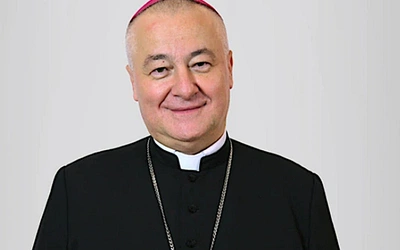
-
Ordo Iuris: prawa „reprodukcyjne i seksualne” nie są prawami człowieka, jak chcą lewicowcy

-
Kościół w Korei Płd. rozwija się „wybuchowo”: 24 proc. wzrost liczby chrztów

Najnowsze
-
1 Rolnicy o ogłoszonej przez rząd pomocy: jest tylko symboliczna, nie odnosi się do przyczyn problemu
-
2 George Weigel o deklaracji Dignitas Infinita: mogłaby bardziej pomóc wojnie kulturowej
-
3 Duda po exposé Sikorskiego: opowiadanie o złej pozycji Polski w UE jest bzdurą
-
4 Bp Ważny w Sosnowcu: pierwsze skojarzenia miałem z konkretnymi osobami, a nie z tym, co pisały media
-
5 Ordo Iuris: prawa „reprodukcyjne i seksualne” nie są prawami człowieka, jak chcą lewicowcy
-
6 Kościół w Korei Płd. rozwija się „wybuchowo”: 24 proc. wzrost liczby chrztów
-
7 Ks. Ptasznik w 10. rocznicę kanonizacji Jana Pawła II: wracać do jego nauczania, odejść od sentymentalnych wspomnień
-
8 Niemiecka droga synodalna: czterech biskupów sprzeciwiło się kontynuacji prac nad „radą synodalną”
-
9 Adwokat ks. Olszewskiego: prokuratura w sposób rażący łamie prawo do obrony
-
10 Wprowadzenie Ustawy Kaucyjnej: krok ku zrównoważonemu środowisku
Najpopularniejsze
- Być ewangelistą
- Blok gazowo-parowy w Rybniku z decyzją o pozwoleniu na budowę
- Praca Opiekunki w Niemczech: Wyzwanie Pełne Satysfakcji
- XXIII Edycja Jarmarku Św. Dominika: Rodzinna integracja na Służewie!
- Spotkanie z okazji 10-lecia kanonizacji Jana Pawła II oraz promocja Jego biografii „Święty Prorok”
- W drodze do domu czy zamknięci w doczesności?
- Mikrolasy Miyawaki – japoński koncept ratunkiem dla polskich miast
- Santander Bank Polska nagrodzony za najlepszą wielokanałową obsługę klienta
- Wprowadzenie Ustawy Kaucyjnej: krok ku zrównoważonemu środowisku
- Argentyński lekarz skazany za ratowanie dziecka. Jego matce nie pomógł żaden orędownik „pro-choice”
Nowości opoki
-
Rolnicy o ogłoszonej przez rząd pomocy: jest tylko symboliczna, nie odnosi się do przyczyn problemu

-
Duda po exposé Sikorskiego: opowiadanie o złej pozycji Polski w UE jest bzdurą

-
Bp Ważny w Sosnowcu: pierwsze skojarzenia miałem z konkretnymi osobami, a nie z tym, co pisały media
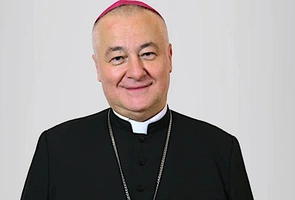
-
Ordo Iuris: prawa „reprodukcyjne i seksualne” nie są prawami człowieka, jak chcą lewicowcy

-
Kościół w Korei Płd. rozwija się „wybuchowo”: 24 proc. wzrost liczby chrztów Liczba chrztów w Korei Południowej wzrosła o 24 proc. w ciągu roku, według statystyk opublikowanych 24 kwietnia przez Konferencję Biskupów Katolickich Korei. Znakiem ugruntowanej pozycji Kościoła jest rekordowa liczba 80 katolików wybranych w tym miesiącu do 300-osobowego Zgromadzenia Narodowego.

-
Ks. Ptasznik w 10. rocznicę kanonizacji Jana Pawła II: wracać do jego nauczania, odejść od sentymentalnych wspomnień „Powinniśmy starać się wracać przede wszystkim do nauczania Jana Pawła II, a odejść od jedynie sentymentalnego patrzenia na tamte lata" – podkreśla w rozmowie z Radiem Watykańskim – Vatican News ks. prałat Paweł Ptasznik przed 10. rocznicą kanonizacji Papieża Polaka.
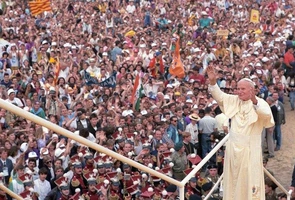
-
Niemiecka droga synodalna: czterech biskupów sprzeciwiło się kontynuacji prac nad „radą synodalną” Czterech członków Rady Stałej Niemieckiej Konferencji Biskupów postanowiło nie uczestniczyć w głosowaniu na temat ustanowienia Komitetu Synodalnego, który ma z kolei doprowadzić do powstania rady synodalnej – stałego gremium składającego się z biskupów i świeckich, które ma zarządzać Kościołem w Niemczech. Dalsze uczestnictwo w tych pracach oznaczałoby zignorowanie zasadniczych zastrzeżeń przeciwko idei „rady synodalnej” zgłaszanych przez Watykan.
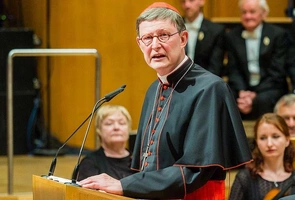
-
Adwokat ks. Olszewskiego: prokuratura w sposób rażący łamie prawo do obrony „Prokuratura konsekwentnie próbuje zrealizować plan wyłączenia wybranych obrońców z czynności procesowych” – poinformował mec. Krzysztof Wąsowski, obrońca ks. Michała Olszewskiego. Jak ocenił, działania prokuratury łamią „konstytucyjne prawo do obrony, przysługujące nie tylko ks. Michałowi Olszewskiemu SCJ, ale także pozostałym podejrzanym”.
